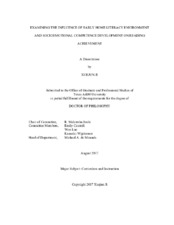| dc.contributor.advisor | Joshi, R. Malatesha | |
| dc.creator | Ji, Xuejun | |
| dc.date.accessioned | 2018-02-05T21:22:39Z | |
| dc.date.available | 2019-08-01T06:52:41Z | |
| dc.date.created | 2017-08 | |
| dc.date.issued | 2017-07-27 | |
| dc.date.submitted | August 2017 | |
| dc.identifier.uri | https://hdl.handle.net/1969.1/166088 | |
| dc.description.abstract | The purpose of this study is to (1) identify the underlying types of home literacy environment (HLE) and their effects on early reading achievement, (2) examine the types of socio-emotional competence (SEC) and their long-term effects on later reading achievement, and (3) investigate the contribution of the HLE and SEC to identify the at-risk readers. Latent Variable Modeling and Decision Tree were used for data analysis.
The sample in this study consisted of 13,367 early graders extracted from the Early Childhood Longitudinal Study Kindergarten dataset (ECLS-K) 2010-2011. The reading achievement variables are the IRT-scaled reading scores at the kindergarten fall and first grade spring. HLE measures include 13 survey items regarding direct and indirect literacy interaction between children and parents. SEC measures are the social skill items based on parent-reported and teacher-reported scales for both grade levels.
Two main types of home literacy environments were identified: pro-reading and contra-reading families. Further analysis indicated that over 70% of the sampled families provided supportive reading environments. Children from the pro-reading families outperformed their contra-reading families in reading achievement. Furthermore, results indicated that the racial groups and socioeconomic status (SES) also differentiate the degree of parental involvement into home literacy activities. Next, students from higher SES families tended to be more likely to experience rich home literacy, and thus obtained early advantage in reading achievement. Meanwhile, these children were more likely to stay in and move to the positive SEC behavior state in comparison with their counterparts from the low SES families, and the negative SEC behavior state was also associated with low reading achievement. Finally, the at-risk reader profile was identified in the Decision Tree Model.
In conclusion, this study examined the effects of the ecological and psychological factors on early reading achievement, and attempted to build a predictive model to identify and profile the at-risk readers. When the students are observed to have the profiled behavior, they might be further diagnosed by a reading specialist and a school psychologist for verification. The teacher can give special attention, extra instruction, and immediate intervention to that particular group. | en |
| dc.format.mimetype | application/pdf | |
| dc.language.iso | en | |
| dc.subject | Home Literacy Achievement | en |
| dc.subject | Reading Achievement | en |
| dc.title | Examining the Influence of Early Home Literacy Environment and Socioemotional Competence Development on Reading Achievement | en |
| dc.type | Thesis | en |
| thesis.degree.department | Teaching, Learning, and Culture | en |
| thesis.degree.discipline | Curriculum and Instruction | en |
| thesis.degree.grantor | Texas A & M University | en |
| thesis.degree.name | Doctor of Philosophy | en |
| thesis.degree.level | Doctoral | en |
| dc.contributor.committeeMember | Cantrell, Emily | |
| dc.contributor.committeeMember | Luo, Wen | |
| dc.contributor.committeeMember | Wijekumar, Kausalai | |
| dc.type.material | text | en |
| dc.date.updated | 2018-02-05T21:22:39Z | |
| local.embargo.terms | 2019-08-01 | |
| local.etdauthor.orcid | 0000-0003-4023-6854 | |


